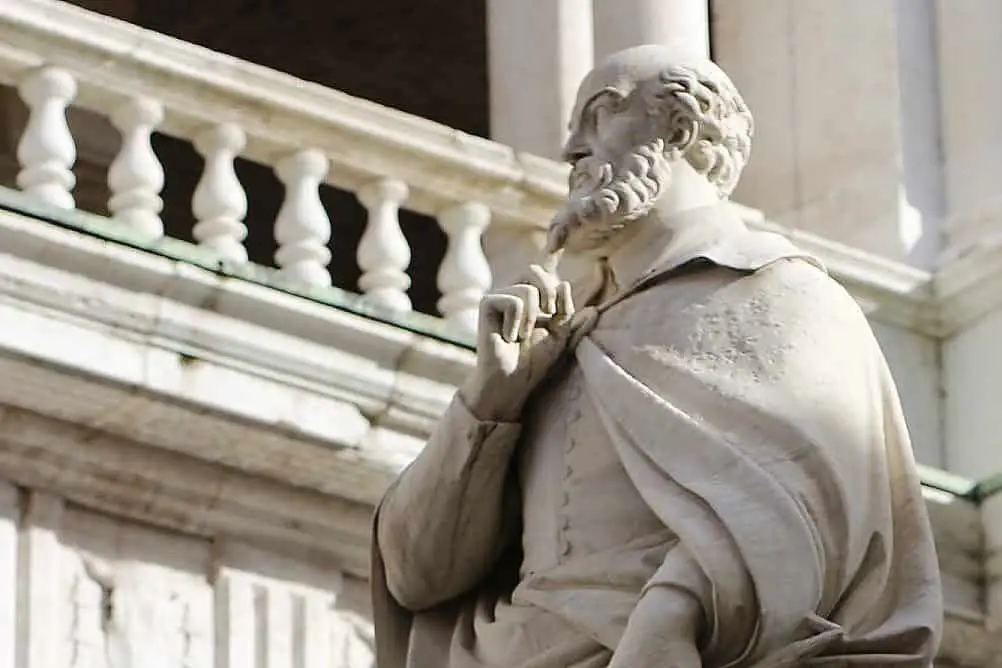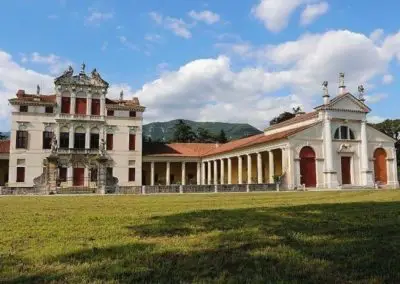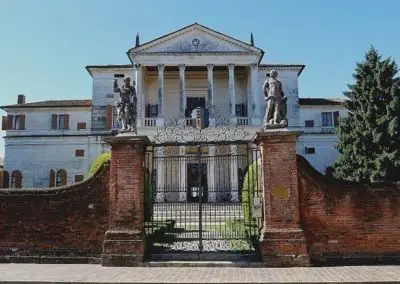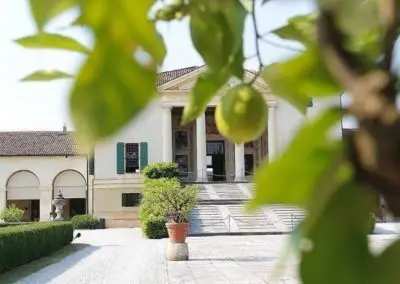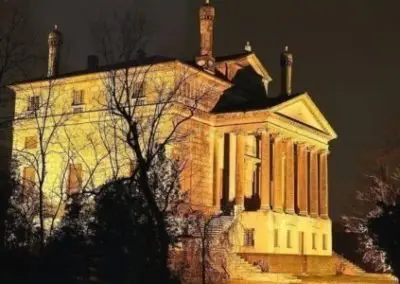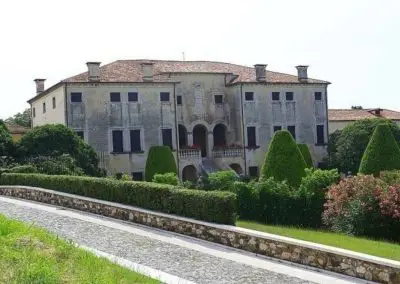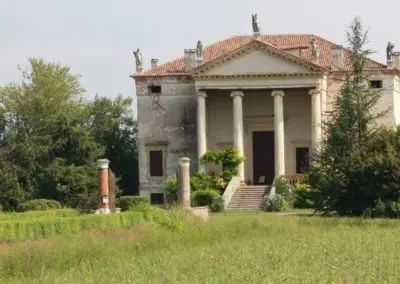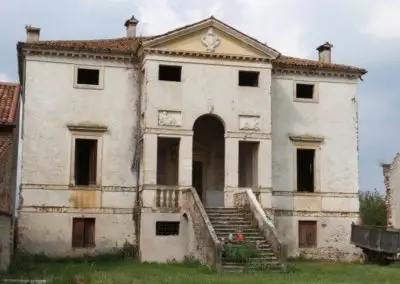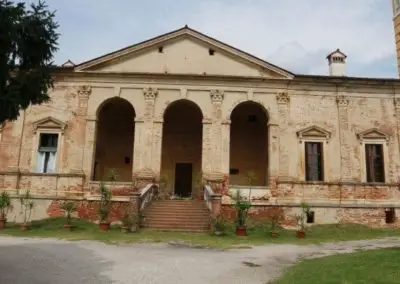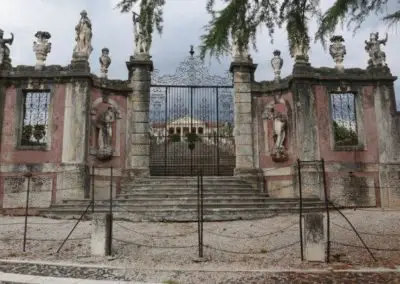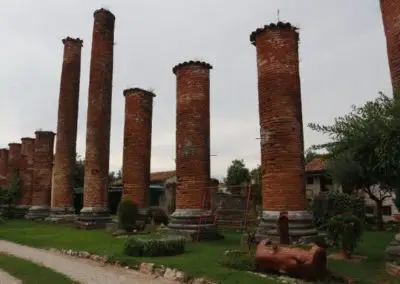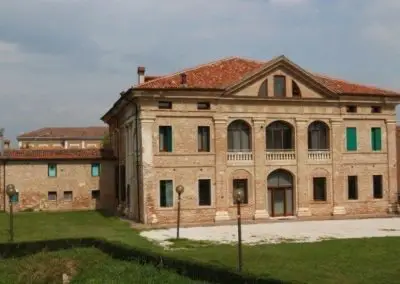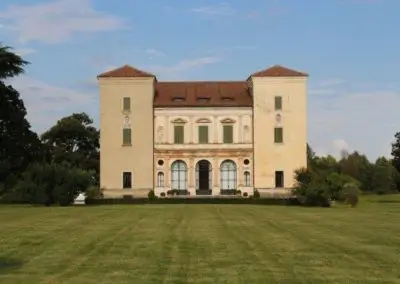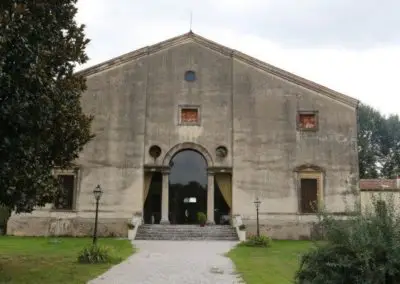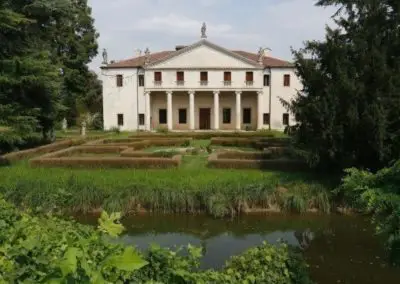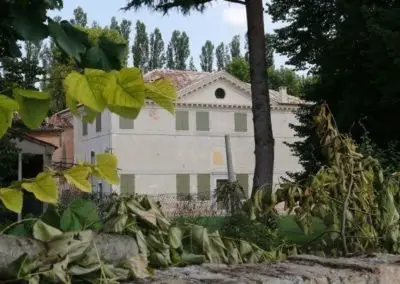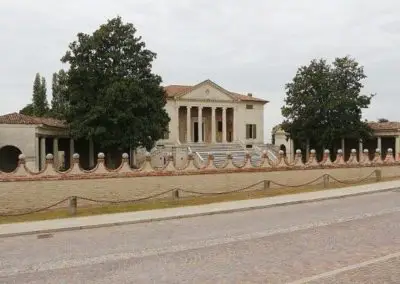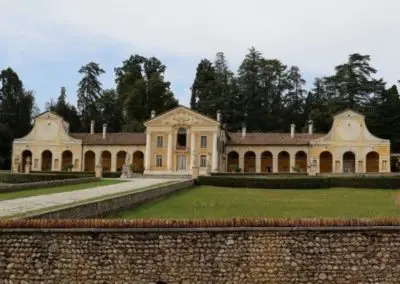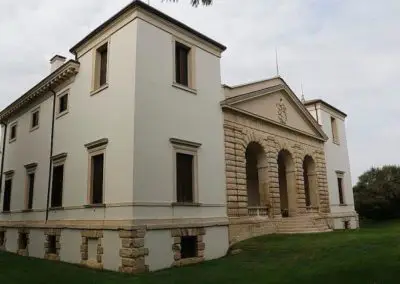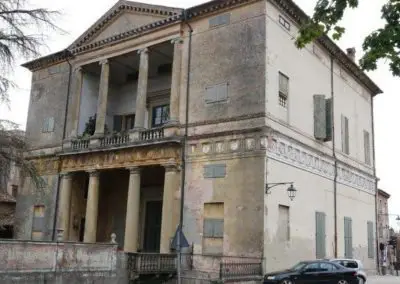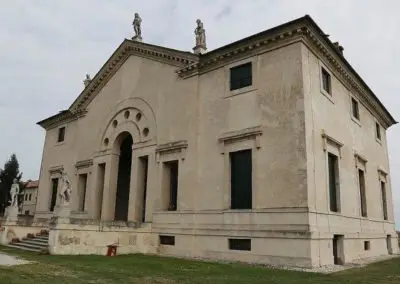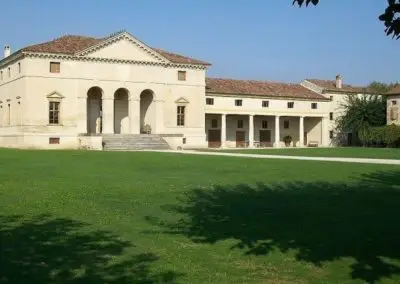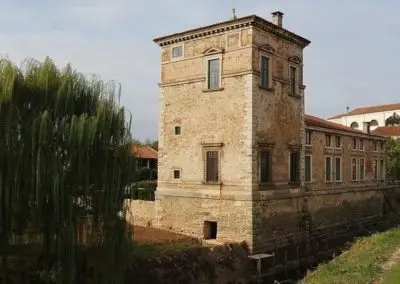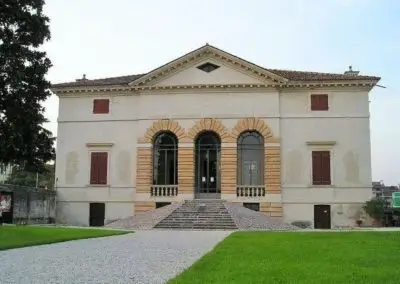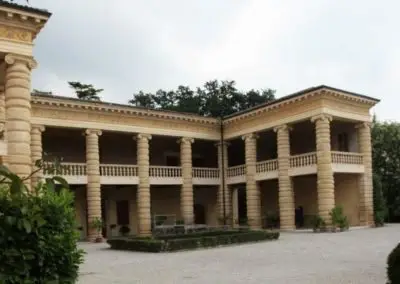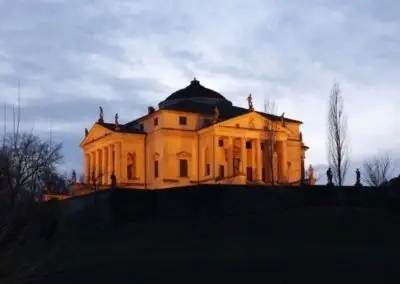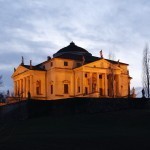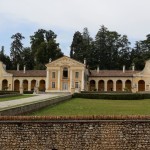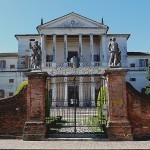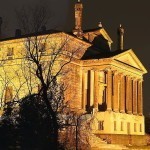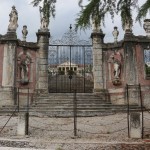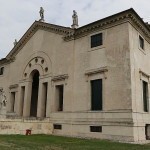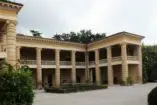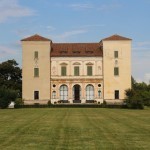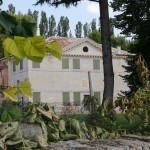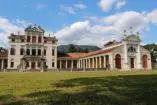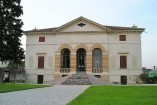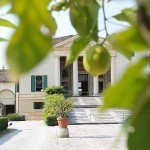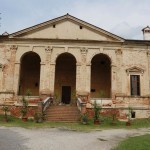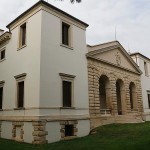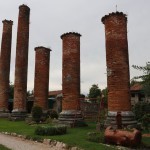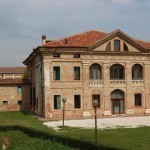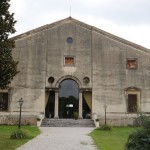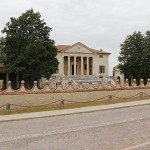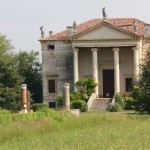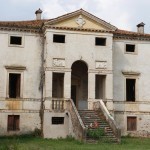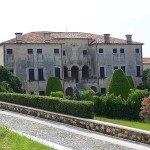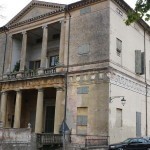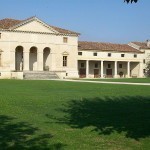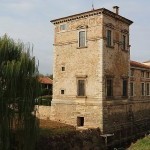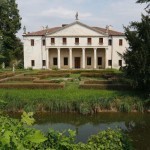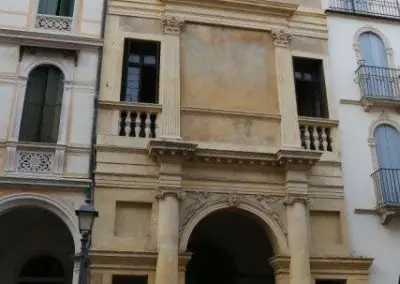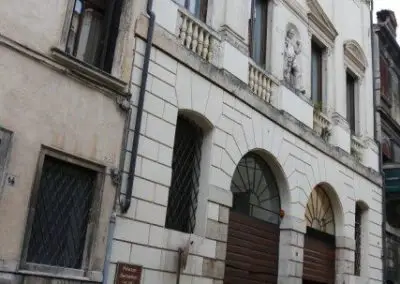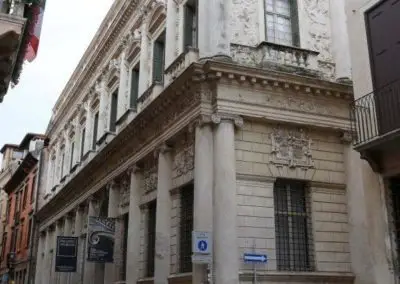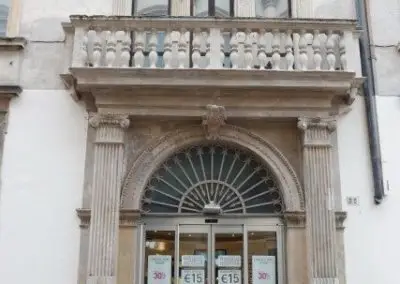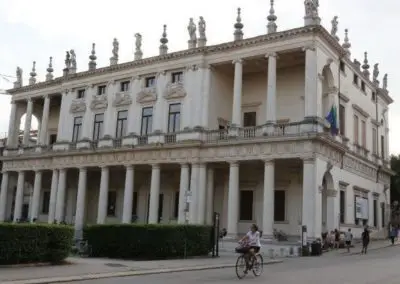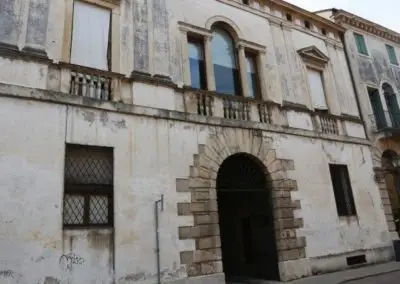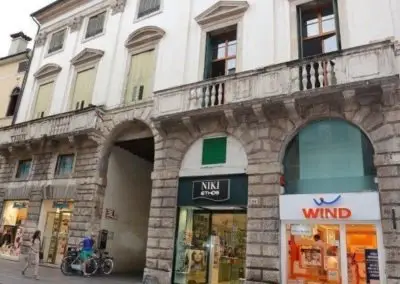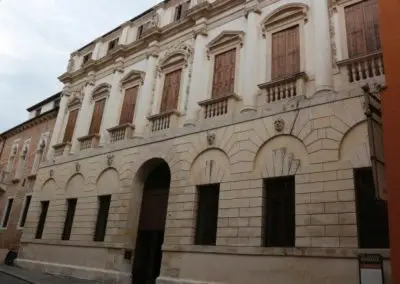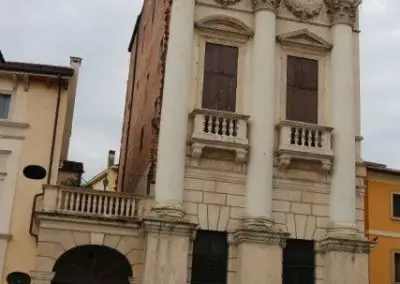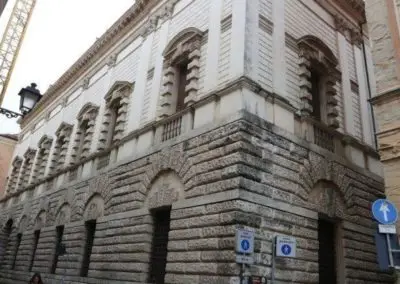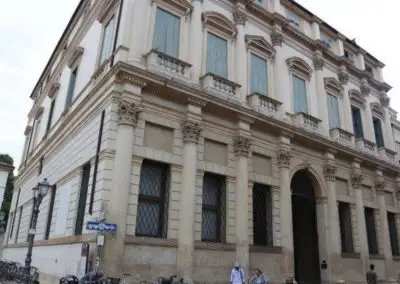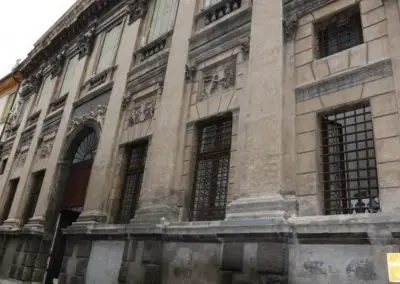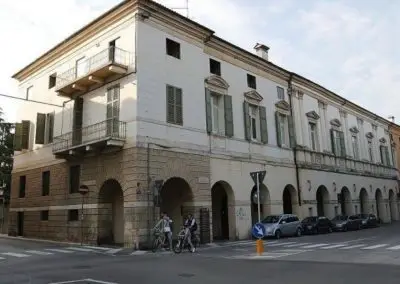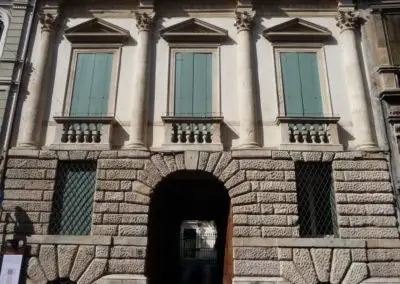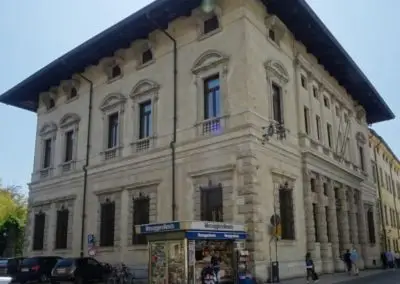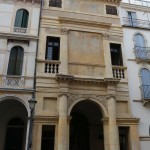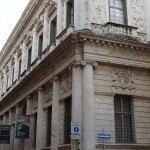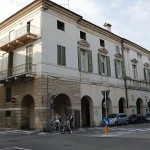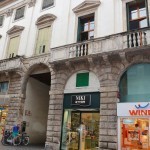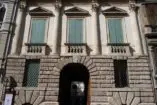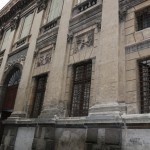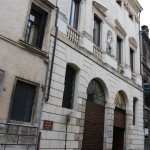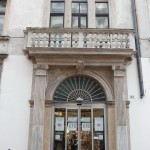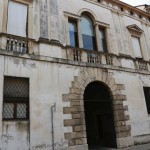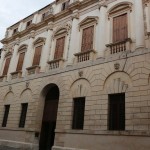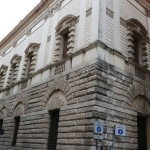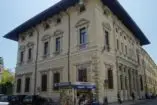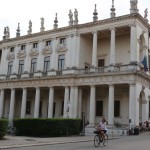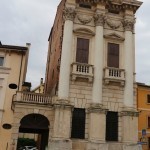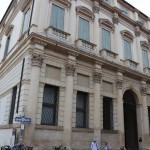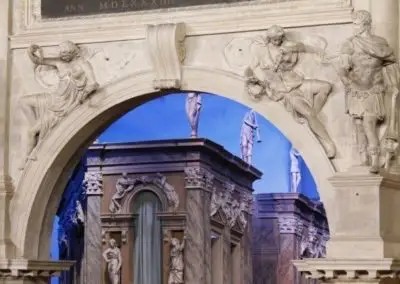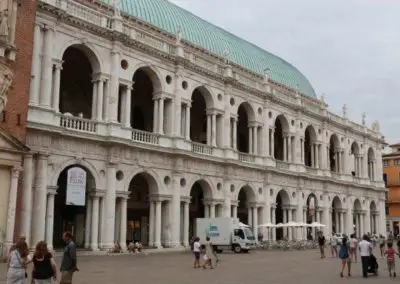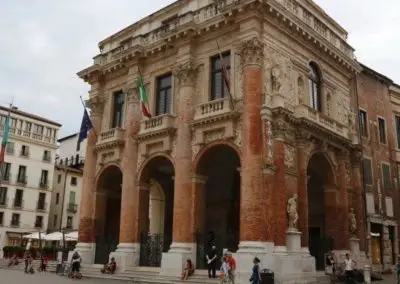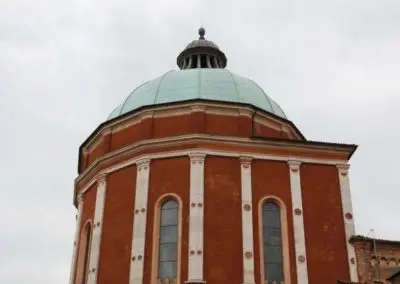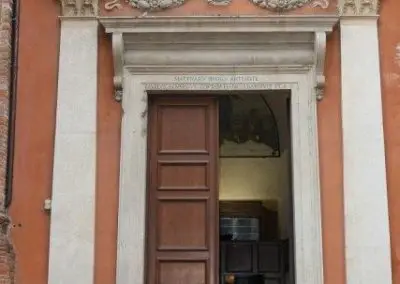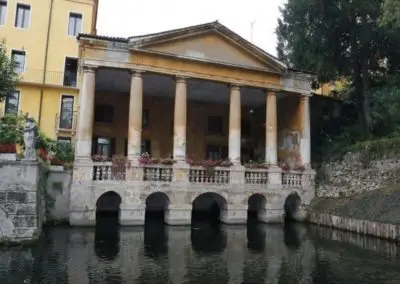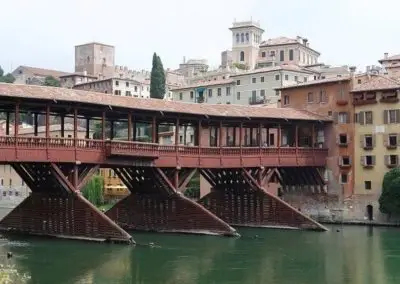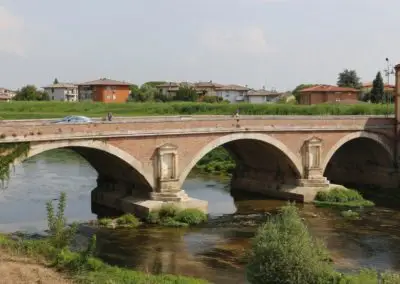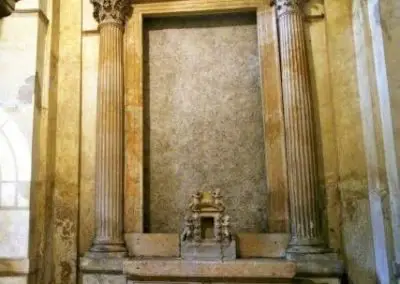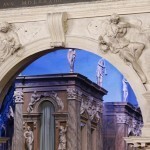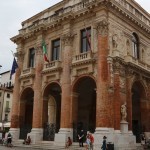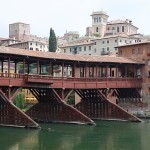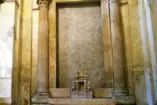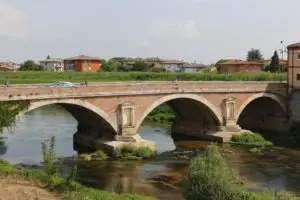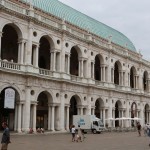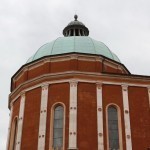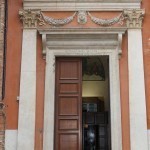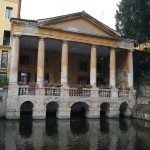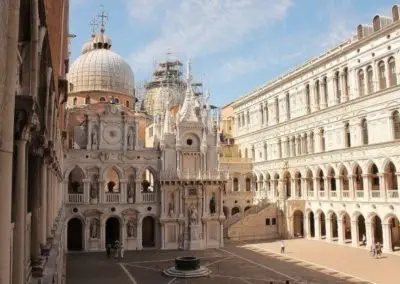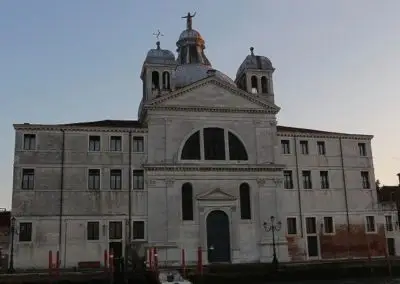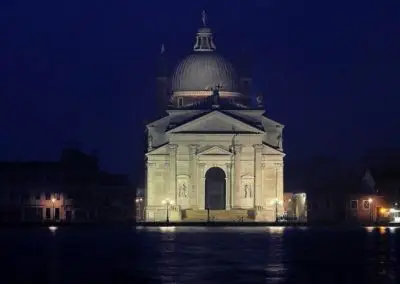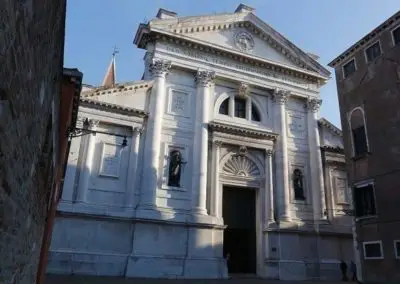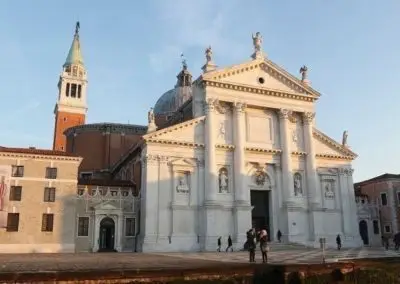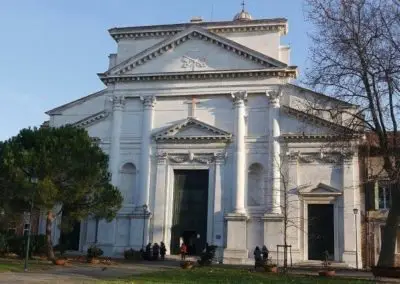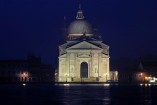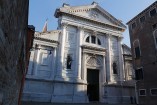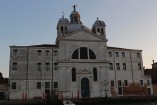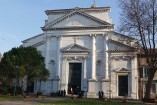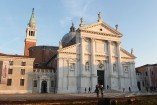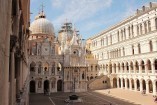L’architecte de la Renaissance vénitienne
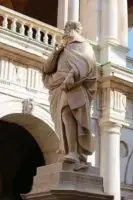
Les théories de Vitruve
Palladio devient un défenseur de l’école architecturale de la pensée vitruvienne fondée sur «firmitas » (solidité), « utilitas » (fonctionnalité) et « venustas » (beauté) et collabore avec Daniel Barbaro pour la traduction et la publication de la première édition critique du traité « Les Dix Livres d’architecture » de Vitruve écrit entre 35 et 25 avant JC. En 1570, il publie « Les Quatre Livres de l’architecture», un ouvrage qui contient les projets de ses quarante an de carrière.
Andrea Palladio et ses oeuvres
Palladio est d’abord un architecte de Palais qui lui donne l’occasion de prouver sa connaissance de l’artisanat et du style. La plupart des palais sont situés à Vicence où leurs nobles façades enrichissent les rues de la ville. On trouve d’autres exemples, comme le « Palazzo Antonini » à Udine et le « Palazzo Dalla Torre » à Vérone. Et on ne peut pas oublier certains travaux publics qu’il a fait!!!
Il meurt en 1580, à l’âge de 72 ans, lors de l’inspection au chantier de construction de la chapelle de Villa Barbaro à Maser.
L’Unesco
Vicence, comme l’UNESCO a décrété, est universellement reconnue comme la ville de Palladio en inscrivant 23 monuments du centre historique et 16 villas de sa province dans la Liste du patrimoine mondial, tous attribués au génie de l’architecture: Andrea Palladio.
Andrea Palladio, l’architecte le plus influent de ces 500 dernières années, a également été reconnu comme le père de l’architecture américaine du Congrès des États-Unis par la Résolution n ° 259/2010, pour l’influence décisive de son style.
Palladio à Venise
Andrea Palladio visite Venise pour la première fois en 1548, à l’âge de 40 ans. Il était alors l’architecte provincial de succès qui travailler sur le territoire continental de la Sérénissime. Mais pendant les trente dernières années de sa vie (il meurt en 1580) il consacre ses efforts à promouvoir et à appliquer ses idées classiques à Venise.
La bureaucratie vénitienne
Pour dix ans, il subit une série de défaites. En fait, sa lutte pour briser la bureaucratie vénitienne étroitement liée restait toujours sans succès. Un système qui contrôlait les principales commissions d’architecture. Ils ont rejeté ses projets pour la construction du pont de Rialto. Ainsi que sa demande de devenir l’architecte des importants magasins du sel. En fait, c’était le riche monopole qui contrôlait le commerce du sel de Venise. Donc une branche qui était également responsable de l’entretien du Palais Ducal.
Daniel et Marcantonio Barbaro
Palladio a fait face à l’opposition des membres du Sénat alliés contre son langage d’architecture « romaine ». Assurément, il ne pouvait pas y arriver sans l’aide de quelque politicien (une histoire qui se répète). Donc, les frères Daniel et Marcantonio Barbaro garantissent pour lui. Ils étaient deux nobles vénitiens érudits et influents. C’est leur soutien décisif qui a permis à Palladio d’obtenir son premier projet dans la ville lagunaire.
Le Patriarche de Venise
Les frères Barbaro étaient ses garants dans le contrat de 1558 avec le patriarche de Venise. Il charge Andrea Palladio de concevoir et de superviser la construction d’une nouvelle façade pour l’église de San Pietro di Castello. À cette époque-là, la vénérable cathédrale de la Sérénissime. Lorsque certains membres du Sénat n’étaient pas encore convaincus des mérites du classicisme de Palladio. Mais la conception de la façade de San Pietro a été accueillie avec enthousiasme. En fait, ce succès ouvre la porte à d’autres commissions prestigieuses. Celles-ci comprenaient le grand couvent de la Carità avec son admirable cloître. Ainsi que la façade de l’église de San Francesco della Vigna.
San Giorgio Maggiore
Cependant, le pas décisif pour Andrea Palladio fut son travail au complexe monastique de San Giorgio Maggiore. Ici, l’Ordre bénédictin donne à Palladio l’occasion de redessiner le réfectoire que le Maître transforme en une structure magnifique. Et aussi pour concevoir et superviser la construction de son premier bâtiment sacré à Venise. C’était la basilique de San Giorgio Maggiore. Un projet avec lequel Palladio reste impliqué en tant que superviseur et plus tard en tant que consultant jusqu’à sa mort.
Palladio en dehors de Venise
En 1570, Palladio était au sommet de sa carrière. En fait, ils sollicitent son travail de consultant non seulement à Venise, mais aussi dans d’autres états italiens. Y compris le duché de Savoie, et même à la cour des Habsbourg à Vienne. Lorsqu’il devient l’architecte officiel de la République. Cependant, Venise lui commande de concevoir son chef-d’œuvre, l’église votive du Redentore sur l’île de la Giudecca. C’était le résultat du voeu fait par le Doge Mocenigo. Construire une église pour commémorer la fin d’une épidémie de peste qui avait décimé la population vénitienne entre 1576 et 1577.
L’église du Rédempteur
L’église du Rédempteur est l’œuvre la plus remarquable de Palladio. Sûrement pour son plan processionnel unique et son intérieur scénographique avec un large escalier qui mène à l’accès. En fait, le Maître le conçoit pour favoriser le progrès solennel de la procession annuelle. Un évènement qui continue jusqu’à nos jours le troisième dimanche de juillet. En traversant le large canal de la Giudecca du Zattere par un pont de bateaux installé pour l’occasion.
Le tempietto Barbaro
La forte amitié avec les frères Barbaro a continué même après la mort de Daniel. En fait, Marcantonio Barbaro donne à Palladio l’opportunité de créer son dernier chef-d’œuvre sacré, le Tempietto. Conçue comme la chapelle de la famille Barbaro sur le terrain de sa villa à Maser. Palladio l’a construit en suivant le plan central de villa Barbaro. Et on s’aperçoit comment il reflét avec soin son admiration pour le célèbre Panthéon de Rome.
Son lexique de l’architecture
Après sa mort, l’influence de Palladio a continué de croître à Venise et à l’étranger. Son célèbre traité, « Les Quatre Livres de l’architecture » publié à Venise en 1570, a certainement contribué à répandre sa renommée. Surtout, un traité avec d’excellents dessins et un texte concis de valeur didactique claire. Avant même son arrivée à Venise, Palladio avait des concepts précis qui faisaient partie de son lexique architectural. En fait, ils ont trouvé une expression concrète dans le remarquable cycle de bâtiments qu’il a créé à Venise. Peut-être le corps le plus influent du travail ecclésiastique dans le monde occidental.
Les Quatre Livres de l'architecture
En 1570, Andrea Palladio publie « Les Quatre Livres de l’architecture« , un traité en quatre volumes, qui représente la publication illustrée la plus précieuse de l’architecture de cette époque.
- Le premier livre de « Les Quatre Livres de l’architecture » décrit les idées de Andrea Palladio au sujet de pureté et de simplicité de l’architecture classique en traitant le choix des matériaux, les techniques de construction et les formes architecturales des ordres dans toutes leurs parties.
- Le deuxième livre contient des dessins de villas, de palais et de bâtiments construits par Andrea Palladio. Ces représentations divergent souvent de l’édifice construit pour un processus d’idéalisation et d’adaptation à la maturité de Andrea Palladio.
- Le troisième livre décrit la façon de construire les routes, les ponts, les places et les églises.
- Le quatrième livre contient les remarques d’un grand nombre de bâtiments historiques.
Villa La Rotonda
The temple of the cardinal Paolo Almerico
The construction of this villa begins in the 1550. Hence Vincenzo Scamozzi completes part of it in the early 17th. In conclusion, it consists in a geometric cube with identic pronaos on all four side. And B Ridolfi decorates the fireplaces in the four corner rooms. While A Maganza, L Dorigny and B Aviani decorate the round center hall. And today it is an outstanding work private owned. This monument is in the UNESCO Word Heritage List.
Villa Barbaro
The farm estate in Maser
The building is built for the Barbaro brothers: Daniele and Marcantonio. Hence here for the first time, the manor house and the barchesse are in line. In fact, the design is to make a compact architecture unity. Probably this solution is due for the location of the villa. Especially relevant on the slopes of a hill. And for the terrain unevenness, costly works would be required. This due with barchesse arranged according to the shape of the slope. Therefore this disposition gives a great view from the road below. Paolo Veronese has decorated the rooms with a splendid cycle of frescoes. For sure they are the most extraordinary of the Venetian Cinquecento. This monument is in the UNESCO World Heritage List.
Villa Cornaro
The two floors palladian villa
Villa Cornaro is set in the village of Piombino Dese. And the owner was a patrician of Venice. It is more a country residence than a villa. However, it is far from the agriculture estate and its dependencies. While its position on the public street emphasizes the ambivalence of the structure. Furthermore, fireplaces are present in all the rooms. The Villa is on two floors with double portico. And the harmony of the interior spaces is important. In fact, the sum of the sizes of the various rooms was deemed « most perfect » in the renaissance architecture. The frescoes of the visited area represent scenes of the Old Testament. This monument is in the UNESCO World Heritage List.
Villa La Malcontenta
Along the Brenta Riviera
La Malcontenta was built to the brothers Nicolò and Alvise Foscari. It seems like the end of the 1550s. And it rises in an isolate block with no agriculture annexes. Whatsoever it’s on the edge of the lagoon and the banks of the river Brenta. More than a “villa-farm”, it presents itself as a villa suburbana. Anyway, from the center of Venice the boat can reach Villa Foscari rapidly. Furthermore, the family was one of the most powerful of the city. Hence their residence has a majestic character unknown in all the Andrea Palladio villas. Recent studies have found a Foscari brothers commission to Palladio. That was for a design of an altar in the church of San Pantalon. Which therefore it documents the relation before the project of the villa.
Villa Piovene Porto Godi
Between the plain and the prealps
The project of this Villa is of Andrea Palladio. Even if the pronaos is from the 1587, after his death. However, in the 18th century, F Muttoni added the two Doric porticos and the entrance gate. Always Muttoni builds the staircase rising to the villa and the double flight of steps leading to the pronaos. Hence Antonio Piovene designed the park behind the 15th century chapel of St Gerolamo. This monument is in the UNESCO World Heritage List.
Villa Pojana
The creative façade
The villa is designed with an unusual appearance. But the actual construction doesn’t quite follow the original project. Anyhow the central section dates back to the 1566 while the left wing is from the 18th century. Furthermore, on the sides of the front staircase, G Albanese (1568) made the statues of Jove and Neptune. And in the interiors, the artists B India and A Canera made the 16th century frescoes. The stuccoes are works of B Ridolfi. This monument is in the UNESCO World Heritage List.
Villa Serego
The Valpolicella landscape
The villa is isolated in the extreme west of Andrea Palladio’s countryside. And it’s also one of his last works. For sure it is an exception of all the Palladio’s Villas. First of all, in all the other villas the manor house dominates on the whole complex. But Here Palladio preferred to articulate the space around the great “void” of the central courtyard. Probably taking his own reconstructions of the antique Roman villa as the model. Instead of brick and render, the great Ionic columns were with blocks of calcareous stone. Anyhow just roughed out and assembled one over the other to create irregular piles. And the type of material used comes from the Sarego family quarries that are not far. For sure the huge dimensions of the columns give a sensation of power.
Villa Trissino Trettenero
Isolated at the doors of Vicenza
The owner of this villa was a noble. And his name was Gian Giorgio Trissino. Therefore He built the villa in the 1537 on the pre-existing Badoer Castle. As a result, he was the mentor of Andrea Palladio. He was also a scholar and the author of « Italia Liberata dai Goti ». Hence he proved himself to be an architect with talent. About the villa, the façade is between two towers that date back to the middle ages. Furthermore, it’s a version of Raphael’s Villa Madama in Rome. In the detail, the pilasters separate the arches of the ground floor. And they are duplicate on the first floor. Just between the rectangular windows with the pediment on the top. Unfortunately, there is no trace of the interior paintings. This monument is in the UNESCO World Heritage List.
Villa Zeno
The most easterly building
The dating of the project for this villa is uncertain. Anyway, this is one of the least known work. Certainly, it’s the easternmost of Palladio’s villas. And recent hypotheses have fixed the date to 1554. Which is to say right after Marco Zeno’s acquisition of the estate of Cessalto. In fact, this date is compatible to the construction period of other villas. As a result like Saraceno and Caldogno built on that time. Certainly, this design is in the Quattro Libri. The project was with large right-angle barchesse. And actually their construction dates back the first decades of the seventeenth century.
Villa Angarano
The Baroque style villa
This villa dates back the 17th century. And The architect B Longhena builds it in his favored style. However, the central section is interesting. Most of all the arched windows are relevant. Because a balustrade connects them. And pilasters separated them. But the feature of the curved tympanum with statues is unusual. Hence Two doric porticos frame the villa that are works of Palladio. Consequently, the right side portico ends with the chapel of the villa. Also this monument is in the UNESCO World Heritage List.
Villa Caldogno
Great arches with rustic frames
This villa dates back 1570. And the owner was Angelo Caldogno. Therefore the façade is harmonious. Due to its three vaulted openings framed with large stones. However, a flight of steps leads to the loggia. The tympanum gives further emphasis to the rusticated frame of the great arches. That is in contrast with the smooth and luminous façade. Furthermore, G A Fasolo, G B Zelotti, A Maganza and G Carpioni have painted beautiful frescoes in various rooms. This villa is in the UNESCO World Heritage List.
Villa Emo
The architecture and the frescoes
Most probably the construction of this villa is in between the years 1557 and 1560. And in those years the noble venetian people accept the architect. As a result, the design of this villa is late than Villa Barbaro at Maser and Villa Badoer in Fratta. With which Villa Emo shares the general setting. However Leonardo Emo is the owner. And he marries Francesco Badoer’s nephew in the 1565. Therefore in the villa, the painter Zelotti made the frescoes of the main rooms. Seems like he was partner and collaborator of Veronese. This building is in the UNESCO World Heritage List.
Villa Gazzotti
The proportion and the harmony
There is no doubt that Andrea Palladio is the architect of this villa. And seems like villa Gazzotti was one of his early works. However the proportion of the façade is harmonious. Hence the three beautiful arches remain its focal point. As a result the architect builds it between 1540 and 1545. This monument is in the UNESCO World Heritage List.
Villa Pisani Bonetti
A residence and a farm
The Chapter XIV of the Second Book of Palladio begins with this villa. This book treats of « Villas of some noble Venetians ». However, villa Pisani Bonetti dates back in between the 1541 and the 1542. As a result, the union of the classic triumph arc and the type of medieval towers is particular. Furthermore, the frieze on the façade is the symbol of the noble counts of Bagnolo. This villa is in the UNESCO World Heritage List.
Villa Porto Thiene
The ten brick columns
This is an extraordinary work of ten brick columns. And it dominates the farmyard of the castle of the Porto family. Precisely it marks the first stage of a project which Palladio conceives on behalf of Iseppo (Giuseppe) Porto. In fact, the patron’s name is on the plinths of the splendid stone column bases, next to the date 1572. Iseppo Porto is the rich protagonist of one of Vicenza’s most important families. And brother in law of both Adriano and Marcantonio Thiene (patrons of the palace with the same name in Vicenza). This noble is already the owner of a palace which Palladio had designed him twenty years earlier. This work is in the UNESCO World Heritage List.
Villa Thiene
Some news of Giulio Romano
Seems like this villa is made to the brothers Thiene. Most of all Giulio Romano made the project of the building. And Palladio modifies it when he becomes the director of the works. Therefore the villa is along the river Tesina. Furthermore, it is in the center of the two great agriculture courts of the Thiene family. However, the project of the villa is quite different from the others. In conclusion, this is an unfinished work. Inside the rooms, Giovanni De Mio with perhaps Bernardino India made the frescoes. As a result, it is in the UNESCO World Heritage List.
Villa Valmarana Bressan
The influence from antiquity
A vast and luxuriant park surrounds this villa. Most relevant is the façade. Where we can see in the center the only opening of the serliana archway. Seems like this feature suggests the attribution to the architect. And inside some frescoes of the 18th century are in the spacious hall. Hence in the central room, all around the upper part, we find a frieze of Pasqualotto. Furthermore, they discover some paintings of the 16th century in one of the rooms. Also this building is in the UNESCO World Heritage List.
Villa Badoer
The Polesine and the Po valley
This villa dates back to the 1554 and the owner was the Venitian noble Francesco Badoer. Hence it’s in the south of the region, in the flat and foggy country of the Polesine. However, the building rises on the site of an ancient medieval castle. And in this work Palladio connects the manor house to the two barchesse that are in semicircle. As a result, this solution protects the stables and the annexes. Furthermore, the manor house of the villa rises on a high basement. Most of all it recalls important precedents. The Villa Medici at Poggio a Caiano, as well as the villa dei Vescovi not far. Even Villa Badoer is in the UNESCO World Heritage List.
Villa Da Porto Rigo
The purity and the elegance
Palladio builds it in the second half of the 16th century. Therefore the architecture scheme of this villa is the more favored of the architect. Most of all the balance of the villa is perfect. Hence the pronaos with its large columns supporting the tympanum is of remarkable elegance. Furthermore, this villa is in the UNESCO World Heritage List.
Villa Forni Cerato
A masterpiece uninhabited
This Villa is one of the early works of Palladio. However, it dates back in between 1540 and 1545. As a result, the middle section has a narrow flight of stairs leading up to a « serliana ». And the openings stand out sharply on the wall surface. Hence above the rectangular openings, the basrelief represents river gods. Without doubt, they are works of a sculptor with A Vittoria influence. This villa is in the UNESCO World Heritage List.
Villa Godi Malinverni
On the hill with view on the plain
This is the first country house designed between 1540 and 1542. Most relevant the centre part recessed between the two massive wings. Of special interest is the rich decoration of the whole first floor « piano nobile ». And also one of the rooms on the ground floor. Therefore G B Zelotti wth many other artists made the frescoes of the main hall and Venus Room. However, Zelotti himself decorates the Arts Room and the ground floor. As follow Battista del Moro made the Muse Room, and many frescoes in the right wing are assign to G Padovano. Even the park is quite beautiful. This villa is in the UNESCO World Heritage List.
Villa Pisani à Montagnana
The Renaissance and the Middle Ages
In the 1552 he designs this building to his friend Francesco Pisani. Hence the project takes place in the neighborhood of the village of Montagnana. And noteworthy Pisani was a noble of Venice. As a result, he was the patron and the friend of important artists. For sure such as Veronese and Maganza. And as well as Vittoria and Palladio. These last two artists work in the construction and decoration of his home. Anyway, the building was in progress in September 1553. But in 1555 the works end with the sculpture decorations. And for the first time, a two storey portico of engaged columns and a two storey loggia crowned with pediments appear in a villa. In addition, a doric frieze surrounds the whole building. On the garden front, the façade of the wall takes on life in the plastic excavation of the portico and the upper loggia.
Villa Saraceno
The Landmark Trust property
At the end of the 1540s the noble Saraceno calls the architect to redesign an existing farm. The site was at Finale di Agugliaro. And also the area was a property of his family. Seems like the project of Palladio was to remodel the whole complex. For sure in the Quattro Libri, he shows the building clamped between two great right-angled barchesse. But the whole restoration remains unfinished. And as a result, the Palladio’s intervention was just to the manor block. On the right side of the farmyard, the buildings are still Quattrocento. While the barchessa was from the beginning of the nineteenth century. This monument is in the UNESCO World Heritage List.
Villa Trissino di Sarego
An incomplete aristocratic villa
This small building is only a part of a majestic complex. And the project was for the Trissino family. Therefore the design in « The Four Books of Architecture » locates the dwelling on the hilltop site. And also it shows four façades and several porches. Close to the villa, we find the original gothic house. Also this building is in the UNESCO world Heritage List.
Villa Valmarana Zen
After the destruction of the wars
Badly damaged by air raids, this villa had a full restoration. First of all Andrea Palladio draws the project in 1570. And as a result in a reproduction of his Books of Architecture. Anyhow the design will change during its construction. The Villa should have had a portico and a loggia in the central section bound by tower like wings. Of remarkable interest is the chapel that dates back to the 1615. And also the statues and the wrought-iron gates. This building is in the UNESCO World Heritage List.
Casa Cogollo
Palais Barbaran da Porto
The count Barbarano
For sure the count Montano Barbarano was the owner of this palace. And since 1997 it houses the Center for Architecture Studies. Also it is in the name of Andrea Palladio who edited the project of the palace. The façade shows the Ionic and Corinthian orders. Hence fine plasters decorate the rooms and the lounge.
Palais Civena Trissino
A nursing center
Also this palace is a project of Andrea Palladio. And today it is a part of the Nursing Home Eretenia. Due for an enlargement that dates back the 1801. Therefore at the end of world war II they renovated the palace. Because heavy bombardments hit all the building.
Palais Pojana
Along the main street
This palace is at the numbers 90/94 of Corso Palladio. And most of all the project was to link another building of Vincenzo Pojana. This was possible thanks to an arch that still visible. And the signed drawing is at the Royal Institute of British Architects in London.
Palais Da Schio
Valmarana Braga Rosa
The supporters
The owners of this palace were the Valmarana. And for sure the family was one of the biggest supporters of Andrea Palladio. Hence for them the architect made this great façade. Most relevant is the giant order. As a result it covers the vertical development of the building.
Casa Garzadori Bortolan
The unachieved palace
For sure the commission of this palace is from the noble Garzadori. And the architect in charge was Palladio. But the death of the commissioner in the 1567 nullified the contract. Hence testimonies that date back to the 1564 support its attribution to the builder. Like also UNESCO recognized, at least one part was end.
Palais Capra
The commercial center
As we can see now a day a commercial space incorporates this building. Hence looking the façade a pediment on four pilasters surmounts an arch. Seems like the noble Capra commissioned it in between the 1540 and the 1545. Hence the building suffered also a big change in the seventeenth century. And for sure due for the construction of the Palazzo Piovini. As a result it destroyed the original palace.
Palais Da Monte Migliorini
Some other work
The Da Monte family is the owner of this palace. And also the building is just in front of the Dominican Convent of Santa Corona. For sure Palladio made the project to the family. Hence the UNESCO includes it in the World Heritage List like other works of the architect.
Palais Iseppo da Porto
A palace to a friend
Andrea Palladio designs for his friend Iseppo the Palace of the city. And also the Villa Molina in the village of Malo. But both buildings are incomplete. Therefore this palace had a better luck. Hence the complex has two residences. And today we can see the façade devided in three sections.
Palais Thiene
A palace for nobles
What you see today, seems to be only part of an imposing restoration. Hence the Thiene family was the owner of this palace. And we talk about the brothers Marcantonio and Adriano. As a reslut they entrust Palladio to follow all the works. And seems like also Giulio Romano worked here.
Palais Antonini Udine
A suburban villa in town
A young noble entrusts the construction of this palace. And his name was Floriano. Most relevant he was a member of one of the most prominent families. And also we talk about the aristocracy of the town of Udine. Seems like works modify the building over the centuries. Hence this palace is ambivalent. As a result it is possible to see a palace with a typology of suburban villa.
Palais Chiericati
The museum in the town
This is a new project for the Palladian vision. As a result a city palace and a suburban villa. And in mid-seventeenth century they complete the building. Most relevant, on what was the river port of the city. Therefore since 1855 it houses the Museo Civico of Vicenza.
Palais Dalla Torre Vérone
Le palais à Vérone
Le seul travail d’Andrea Palladio dans la ville de Vérone, le Palais a été commandé par Giambattista Dalla Torre lié par des raports de parenté avec Valmarana et Marcantonio Thiene de Vicence.La connaissance de la consistance réelle du bâtiment est imparfaite, rendue encore plus difficile par un bombardement des Alliés en 1945
Palais Porto Breganze
The giant columns
This palace is in piazza Castello. And it is evident that it is a Palladian construction site. Hence that was end before completion of the project. As a result the front view consists of giant columns. We can see three Corinthian half-columns and two intercolumns of seven planned.
Thiene Bonin Longare
A Scamozzi work
The construction of this palace ends around the 1593. As a result Scamozzi made the works. And on the project of Andrea Palladio. Hence it is clear the paternity of the architect. However the owner of the building is Thiene Bonin Longare. And today it houses the headquarters of the Industrialists.
Théâtre olympique
The theatre that we continue to use
Palladio’s last work is one of his greatest. Hence the construction begins in the 1580, just before Palladio died. And his pupil Scamozzi completes it. Therefore the theater is a wood and stucco festival. Furthermore we can see classic columns, statues and a stage bursting with perspective tricks. And behind the stage, framed by a triumphal arch, five streets recede at different angles. In contrast to the stunning stage, the audience’s wooden benches are simple and crude. One of the oldest indoor theaters in Europe and one of the world’s best, it still uses for performances.
Loge du Capitaine
With a Middle Ages building
This building was the headquarter of the Venetian governor. And today it houses the City Council. Hence Palladio got the task to rebuild the existing building of the Middle Ages. And seems like after 20 years of the project of the Basilica’s loggias. Therefore the façade onto the Contra’ del Monte would be as a sort of triumphal arch. In fact it reports the victory of the Venetian forces against the Turks at the battle of Lepanto in October 1571.
Le Ponte Vecchio
The wooden bridge
Bassano del Grappa is the town where we can find this bridge. We also call it Ponte degli Alpini (Alpini’s bridge). Hence Andrea Palladio designed this covered wooden bridge in the 1569. Therefore the bridge collapsed many time during the centuries for destructive flood. And the last time in World War II. But the reconstruction respects always the Palladio’s design. The bridge spans the river Brenta.
La chapelle Valmarana
The chapel in Santa Corona church
Andrea Palladio made this chapel in the 1576. Maybe after the death of the noble Antonio Valmarana. And the location is in the crypt of St Corona, one of the most important churches. Also the tomb of Palladio was in this church. But today his chapel is in the cemetery of the city. In the same years Palladio designed the lateral chapels of the church of the Redentore in Venice. Hence arranging in sequence a series of spaces identic to the one of this Chapel.
Pont sur la rivière Tesina
The model of an ancient bridge
The bridge with three arches spans the Tesina river in the village of Torri di Quartesolo. And maybe the project originates from an idea of Palladio in the 1569. However the construction starts in the 1580. Hence Groppino was the supervisor of the works. Seems like Palladio took as his model a work of the ancient Rome period that he had seen and appreciated in Rimini. And from which derive the tabernacles placed against the pillars. We talk about the bridge of Augustus and Tiberius built between 14 and 21 AD. As a result this stone bridge is the only one of Andrea Palladio and joint to the present days.
La basilique palladienne
A structure based on serliana
This building is the admission of Palladio to the elite of the architects of his time. Hence in the 1546 they approve his design for a new façade of the pre existing building. And his project prevails over the ones of important architects of that time. Therefore the basilica had works over the centuries. And for sure until the present years, from 2007 to 2009. Furthermore 60 years after the restoration works following the bombing of Word War II.
Dôme et portail de la cathédrale
The cathedral in the town of Vicenza
Palladio made the dome around the 1565, almost twenty years after the work of the apse. Furthermore the north side door, a replacing of a gothic one, was open in the 1575. And Paolo Almerico was the comissioner. Hence he was the owner of Villa La Rotonda. The lantern was also on the summit of the cupolas of San Giorgio Maggiore in Venice that dates of the same years. And it is also present in some reconstructions of antique temples. Hence like the Mausoleum of Romulus.
Loge dans le jardin Salvi
The garden close to the western medieval gate
First of all a triangular pediment is on the loggia of six Doric columns. And as a result the building is in the Salvi gardens of Vicenza. Seems like it follows a project close to the Palladian style, if not by the same architect. Hence UNESCO in the 1994 attributes it to Andrea Palladio.
Saint Rédempteur
This church was the final station for the procession of the Redeemer’s day. And the Senate wanted this votive temple after the plague of 1576. Hence Palladio started the construction and Da Ponte completed it in the 1592. In summer 1575 a terrible plague hits Venice that in two years will cause 50000 deaths. Almost one Venetian in three. In September 1576, when the plague seemed invincible against human efforts, the Senate pleaded for divine help. They vote to build a new church dedicated to the Redeemer.
The project
And in May 1577 it laid the first stone of Palladio’s project. As a result on July 20th of the same year the end of the plague is celebrated with a procession to the church across a pontoon bridge. Especially relevant this event starts a tradition that continues today. In the façade of the church of the Redeemer, Palladio attained the highest result of his Venetian experience.
San Francesco della Vigna
This church is located in Campo San Francesco della Vigna, off the tourist routes. First of all founded in the Gothic style for the Franciscans in 1300, Jacopo Sansovino rebuilt it since 1534. For sure the project of the architect presents mature Renaissance principles.
The noble Venetians
Hence in 1564 Andrea Palladio starts the construction of the façade. And thanks to the support of Daniele Barbaro, he manages to get the job to build it. However it excludes the first architect from the project. Seems like most of Venetian preferred the Palladian style.
Église des Zitelle
At the eastern end of the Giudecca island, in Venice, the Church of St Mary of the Presentation known as Zitelle (spinsters). However this religious complex of the Spinsters known as St Mary of the Presentation was built in 1579-86 following Palladio’s project.
The complex
Anyway the two symmetrical wings beside the church were hospice for young poor girls. For sure the complex gives a clear architectural unity. Furthermore inside the church there is a large square room. Anyhow the Jesuit Benedetto Palmi creates the church to assist poor girls. Hence today the building is part of an ecclesiastic complex.
San Pietro in Castello
The island of San Pietro is located at the eastern end of Venice. Seems like first inhabited of the area. And nowadays the place presents it self secluded and picturesque. Furthermore the religious power was here from 800 to 1807. Hence the campo San Pietro is open in front of a wide channel with the same name. And it is a corner where dominates the isolated Renaissance bell tower.
Vincenzo Diedo
Therefore Palladio made the project of the monumental façade of the church. And this was his first work in Venice. But just two years after the works interrupted due to the death of the customer, the patriarch Vincenzo Diedo. They will be completed much later, in the late sixteenth century. The actual façade does not reflect exactly Palladio’s design, but it reports his essential lines.
San Giorgio Maggiore
From Saint Mark square the island of San Giorgio Maggiore has one of the most beautiful views of Venice. Especially relevant greatest painters of all time made this place so famous. Here Palladio starts the construction of the building in 1566. Hence the church is finished the first half of the seventeenth century after his death.
The church and Vasari
The construction of this big church is undoubtedly his most complex and difficult building site. Palladio began the works after the end of the refectory. The church in a scale to the approval of the customer will arouse admiration in Vasari passing in Venice. Seems like the ancient Roman thermal baths inspired the architect. For sure he admires the ruins during his journey in Rome.
Palais des Doges
On May 11th 1574 a fire destroyed some of the Doge’s Palace Piano Nobile rooms in Venice. Therefore Andrea Palladio takes the work to restore some rooms. And we can find his hand in three rooms.
The Piano Nobile rooms
In conclusion the rooms are the « Sala delle Quattro Porte« , the « Anticollegio » and the « Sala del Collegio« . Furthermore we find him for a second restauration on 1577 and 1578.
Les randonnées journalières
Il est clair que Andrea Palladio est le père de l’architecture vénitienne de la renaissance. Donc, tous ses travaux sont des chef-d’œuvres mondialement connus. Afin de les découvrir, nous proposons des itinéraires d’une journée dans la région de la Vénétie . ou vous pouvez trouver des solutions qui peuvent bien vous satisfaire. N’hésitez pas à nous contacter.
